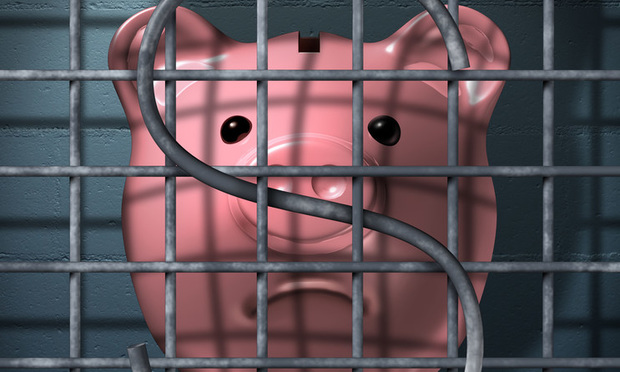Effect of Rejected Trademark License Agreement on Rights of Use
Section 365(a) of the Bankruptcy Code permits a debtor or trustee, subject to bankruptcy court approval, to reject an executory contract and release the debtor's estate from burdensome contractual obligations that may impede the debtor's successful reorganization.
August 16, 2018 at 03:06 PM
7 minute read
 Photo credit: Bigstock
Photo credit: Bigstock
Section 365(a) of the Bankruptcy Code permits a debtor or trustee, subject to bankruptcy court approval, to reject an executory contract and release the debtor's estate from burdensome contractual obligations that may impede the debtor's successful reorganization. Section 365(n) sets forth a provision that affords special protection to licensees of “intellectual property,” as that term is defined by Section 101(35A) of the Bankruptcy Code. The provision allows such licensees, in the event of rejection, to make an election to retain their rights to the debtor's intellectual property, subject to certain requirements and conditions set forth therein.
Section 365(n) was enacted in 1998 in response to the Fourth Circuit Court of Appeals' decision in Lubrizol Enterprises v. Richmond Metal Finishers, 756 F.2d 1043 (4th Cir. 1985), in which it was held that a debtor's rejection of an intellectual property license terminated all of the licensee's contractual rights under the license agreement and left the licensee with nothing more than a claim for money damages.
In conjunction with the enactment of Section 365(n), Congress amended the Section 101(35A) defined term “intellectual property” to include trade secrets, patents and patent applications, plant varieties, copyrights, and mask work protected under Chapter 9 of U.S.C. title 17. However, the definition does not include trademarks.
Earlier this year, the U.S. Court of Appeals for the First Circuit issued its decision in Mission Products Holdings v. Tempnology n/k/a Old Cold, 879 F.3d 389 (1st Cir. 2018), which resulted in a circuit split on the effect on trademark licenses of a debtor's rejection. Because Code Section 101(35A) omits “trademarks” from the definition of “intellectual property,” the First Circuit declined to follow the Seventh Circuit Court's approach in Sunbeam Products v. Chicago American Manufacturing, 686 F.3d 372 (7th Cir. 2012), and held that a debtor's rejection of a trademark license strips the trademark licensee of its right to use the trademarks post-rejection.
The Seventh Circuit Court of Appeals Approach
Reasoning that “an omission is just an omission,” the Seventh Circuit Court of Appeals, in Sunbeam, determined that the limited definition of “intellectual property” under Section 101(35A) has no effect on a trademark licensee's rights to use trademark post-rejection.
Examining the legislative history of this code section, the court noted that the omission of trademarks from the definition set forth in Section 101(35A) was simply due to Congress' intention to postpone congressional action with respect to trademarks, in order to allow for more extensive study it deemed necessary, and not to codify the Lubrizol holding.
In its decision, the Seventh Circuit Court criticized the Lubrizol decision, opining that the Fourth Circuit had confused rejection of a contract with termination of that contract. Instead, the Sunbeam court found it more appropriate to apply Code Section 365(g), which classifies rejection as a breach of contract rather than a termination of the parties' rights under the contract. The consequence of treating rejection as a breach was to excuse the estate's continued performance under the contract, at the same time leaving the licensee's trademark rights in place.
The 'Tempnology' Case
Tempnology, LLC (Tempnology) was a textiles company that had developed a chemical-free cooling fabric used to produce athletic performance apparel and accessories. Before Tempnology's bankruptcy, Tempnology and Mission Product Holdings, Inc. entered into a marketing and distribution agreement that granted Mission, among other rights, a limited and non-exclusive license to use certain Tempnology trademarks.
After filing its Chapter 11 petition in 2015, Tempnology immediately sought to reject the agreement with Mission under Section 365(a). Mission made a Section 365(n) election, which led to a dispute over whether Mission's trademark rights fell within the scope of the protections afforded to licensees by Section 365(n).
The Bankruptcy Court for the District of New Hampshire held that Mission was not able to retain its right to use the trademarks post-rejection, reasoning that the omission of “trademarks” from the definition of “intellectual property” set forth in Section 101(35A) rendered trademark rights ineligible for the protections afforded by Section 365(n). On appeal, the Bankruptcy Appellate Panel reversed the bankruptcy court, electing instead to follow the Sunbeam approach.
The First Circuit Court then rejected Sunbeam, determining that trademark licenses are not afforded the protection of 365(n), “unless and until Congress should decide otherwise.” The court determined that, by omitting trademarks from Section 101(35A), Congress did not intend to allow a trademark licensee to continue to use a debtor's trademark once the debtor rejected the license. The court identified seven sections of the Bankruptcy Code where Congress had expressly “granted bankruptcy courts the ability to 'equitably' craft exceptions to the code's rules,” and noted that such an express grant of authority was absent from Section 365(n).
Certiorari to Resolve the Circuit Split
On June 11, Mission filed a petition for a writ of certiorari, requesting that the U.S. Supreme Court step in to resolve the circuit split. The Supreme Court has directed Tempnology to file a response to Mission's petition, which response deadline has been extended to Sept. 7.
On July 11, the International Trademark Association filed its amicus curiae brief in support of Mission's petition. As acknowledged by INTA in its amicus brief, this is the first opportunity that the Supreme Court has had to rule on the issue since denying a petition for certiorari in the Sunbeam case. INTA further notes in its brief that bankruptcy courts in California, Delaware and Rhode Island have adopted the Lubrizol rationale, while bankruptcy courts in Colorado, Connecticut and New Jersey have followed Sunbeam.
In its amicus brief, the INTA urges the Supreme Court to adopt the Sunbeam approach. It argues that this approach will enhance the value of trademark licenses and promote the stability of the trademark system by benefiting licensors through increased upfront fees and royalties for post-rejection use of trademark rights and benefiting licensees, who will not be deprived of their bargained-for trademark rights. INTA further argues that the American consumer will be the “ultimate beneficiary” of a stronger trademark system.
The split has continued to widen since the First Circuit Court issued its decision earlier this year. In May, the U.S. Bankruptcy Court for the District of Connecticut issued a decision in In re SIMA International, 2018 WL 2293705 (Bankr. D. Conn. May 17, 2018), rejecting the Tempnology rationale, which it characterized as the “effective resurrection” of Lubrizol. The bankruptcy court instead aligned itself with the Sunbeam court, and held that neither Section 365(g) (applying Connecticut state law), nor Section 365(n) provided a basis for terminating the licensee's rights in the debtor's trademark, as the estate's rejection was not a material breach.
Based on the apparent need for greater predictability in connection with a debtor's rejection of trademark licenses, it is more likely than not that the U.S. Supreme Court will grant certiorari and resolve the circuit split on this issue.
Rudolph J. Di Massa Jr., a partner at Duane Morris, is a member of the business reorganization and financial restructuring practice group. He concentrates his practice in the areas of commercial litigation and creditors' rights.
Keri L. Wintle practices in the area of business reorganization and financial restructuring with a focus on bankruptcy and creditors' rights.
This content has been archived. It is available through our partners, LexisNexis® and Bloomberg Law.
To view this content, please continue to their sites.
Not a Lexis Subscriber?
Subscribe Now
Not a Bloomberg Law Subscriber?
Subscribe Now
NOT FOR REPRINT
© 2025 ALM Global, LLC, All Rights Reserved. Request academic re-use from www.copyright.com. All other uses, submit a request to [email protected]. For more information visit Asset & Logo Licensing.
You Might Like
View All
AI and Social Media Fakes: Are You Protecting Your Brand?

Neighboring States Have Either Passed or Proposed Climate Superfund Laws—Is Pennsylvania Next?
7 minute read
Seven Rules of the Road for Managing Referrals To/From Other Attorneys, Part 2
6 minute readTrending Stories
- 1No Two Wildfires Alike: Lawyers Take Different Legal Strategies in California
- 2Poop-Themed Dog Toy OK as Parody, but Still Tarnished Jack Daniel’s Brand, Court Says
- 3Meet the New President of NY's Association of Trial Court Jurists
- 4Lawyers' Phones Are Ringing: What Should Employers Do If ICE Raids Their Business?
- 5Freshfields Hires Ex-SEC Corporate Finance Director in Silicon Valley
Who Got The Work
J. Brugh Lower of Gibbons has entered an appearance for industrial equipment supplier Devco Corporation in a pending trademark infringement lawsuit. The suit, accusing the defendant of selling knock-off Graco products, was filed Dec. 18 in New Jersey District Court by Rivkin Radler on behalf of Graco Inc. and Graco Minnesota. The case, assigned to U.S. District Judge Zahid N. Quraishi, is 3:24-cv-11294, Graco Inc. et al v. Devco Corporation.
Who Got The Work
Rebecca Maller-Stein and Kent A. Yalowitz of Arnold & Porter Kaye Scholer have entered their appearances for Hanaco Venture Capital and its executives, Lior Prosor and David Frankel, in a pending securities lawsuit. The action, filed on Dec. 24 in New York Southern District Court by Zell, Aron & Co. on behalf of Goldeneye Advisors, accuses the defendants of negligently and fraudulently managing the plaintiff's $1 million investment. The case, assigned to U.S. District Judge Vernon S. Broderick, is 1:24-cv-09918, Goldeneye Advisors, LLC v. Hanaco Venture Capital, Ltd. et al.
Who Got The Work
Attorneys from A&O Shearman has stepped in as defense counsel for Toronto-Dominion Bank and other defendants in a pending securities class action. The suit, filed Dec. 11 in New York Southern District Court by Bleichmar Fonti & Auld, accuses the defendants of concealing the bank's 'pervasive' deficiencies in regards to its compliance with the Bank Secrecy Act and the quality of its anti-money laundering controls. The case, assigned to U.S. District Judge Arun Subramanian, is 1:24-cv-09445, Gonzalez v. The Toronto-Dominion Bank et al.
Who Got The Work
Crown Castle International, a Pennsylvania company providing shared communications infrastructure, has turned to Luke D. Wolf of Gordon Rees Scully Mansukhani to fend off a pending breach-of-contract lawsuit. The court action, filed Nov. 25 in Michigan Eastern District Court by Hooper Hathaway PC on behalf of The Town Residences LLC, accuses Crown Castle of failing to transfer approximately $30,000 in utility payments from T-Mobile in breach of a roof-top lease and assignment agreement. The case, assigned to U.S. District Judge Susan K. Declercq, is 2:24-cv-13131, The Town Residences LLC v. T-Mobile US, Inc. et al.
Who Got The Work
Wilfred P. Coronato and Daniel M. Schwartz of McCarter & English have stepped in as defense counsel to Electrolux Home Products Inc. in a pending product liability lawsuit. The court action, filed Nov. 26 in New York Eastern District Court by Poulos Lopiccolo PC and Nagel Rice LLP on behalf of David Stern, alleges that the defendant's refrigerators’ drawers and shelving repeatedly break and fall apart within months after purchase. The case, assigned to U.S. District Judge Joan M. Azrack, is 2:24-cv-08204, Stern v. Electrolux Home Products, Inc.
Featured Firms
Law Offices of Gary Martin Hays & Associates, P.C.
(470) 294-1674
Law Offices of Mark E. Salomone
(857) 444-6468
Smith & Hassler
(713) 739-1250






